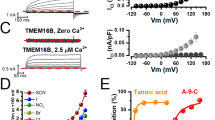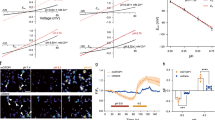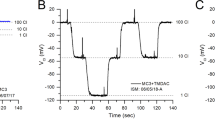Abstract
IT is well known that introducing acid into a cell causes a rapid fall in intracellular pH (pHi) which is followed by a slower rise1–5. Since this return of pHi towards its original value could not be accounted for by the passive transmembrane movement of H+, OH−, or HCO3−, it was ascribed to the active removal of acid from the cell1,2. In the squid giant axon, this acid extrusion is reversibly blocked by cyanide and greatly enhanced by HCO3−/CO2 (ref. 3). More recently, it has been found that acid extrusion in the snail neurone also is stimulated by HCO3−/CO2 (ref. 4), and that, in addition, it is inhibited by 4-acetamido-4′-isothiocyano-stilbene-2,2′-disulphonic acid (SITS)5, a known inhibitor of anion fluxes in erythrocytes6. In this respect it is interesting to note that a component of Cl− efflux in barnacle muscle also is stimulated by HCO3−/CO2 and blocked by SITS7. We now report that acid extrusion in the squid axon requires internal Cl− and ATP, that it is blocked by SITS, and that it is accompanied by the SITS-sensitive efflux of an equivalent amount of Cl−. These observations suggest that acid extrusion actually involves the neutral exchange of external HCO3− for internal Cl−.
This is a preview of subscription content, access via your institution
Access options
Subscribe to this journal
Receive 51 print issues and online access
$199.00 per year
only $3.90 per issue
Buy this article
- Purchase on Springer Link
- Instant access to full article PDF
Prices may be subject to local taxes which are calculated during checkout
Similar content being viewed by others
References
Thomas, R. C., J. Physiol., Lond., 238, 159–180 (1974).
Boron, W. F., and DeWeer, P., J. gen. Physiol., 67, 91–112 (1976).
Boron, W. F., and DeWeer, P., Nature, 259, 240–241 (1976).
Thomas, R. C., J. Physiol., Lond., 255, 715–735 (1976).
Thomas, R. C., Nature, 262, 54–55 (1976).
Cabantchik, Z. I., and Rothstein, A., J. membr. Biol., 15, 207–226 (1974).
Russell, J. M., and Brodwick, M. S., Biophys. J., 16, 156a (1976).
Brinley, F. J., Jr., and Mullins, L. J., J. gen. Physiol., 50, 2303–2331 (1967).
Mullins, L. J., and Brinley, F. J., Jr., J. gen. Physiol., 50, 2333–2355 (1967).
Nadarajah, A., Leese, B., and Joplin, G. F., Int. J. appl. Rad. Isotopes, 733–735 (1969).
Author information
Authors and Affiliations
Rights and permissions
About this article
Cite this article
RUSSELL, J., BORON, W. Role of chloride transport in regulation of intracellular pH. Nature 264, 73–74 (1976). https://doi.org/10.1038/264073a0
Received:
Accepted:
Issue Date:
DOI: https://doi.org/10.1038/264073a0
This article is cited by
-
Unprecedently large 37Cl/35Cl equilibrium isotopic fractionation on nano-confinement of chloride anion
Scientific Reports (2022)
-
pH and male fertility: making sense on pH homeodynamics throughout the male reproductive tract
Cellular and Molecular Life Sciences (2019)
-
Effect of Prediabetes on Membrane Bicarbonate Transporters in Testis and Epididymis
The Journal of Membrane Biology (2013)
-
Membrane Transporters and Cytoplasmatic pH Regulation on Bovine Sertoli Cells
Journal of Membrane Biology (2009)
-
ATP Dependence of Na+-Driven Cl–HCO3 Exchange in Squid Axons
Journal of Membrane Biology (2008)
Comments
By submitting a comment you agree to abide by our Terms and Community Guidelines. If you find something abusive or that does not comply with our terms or guidelines please flag it as inappropriate.



